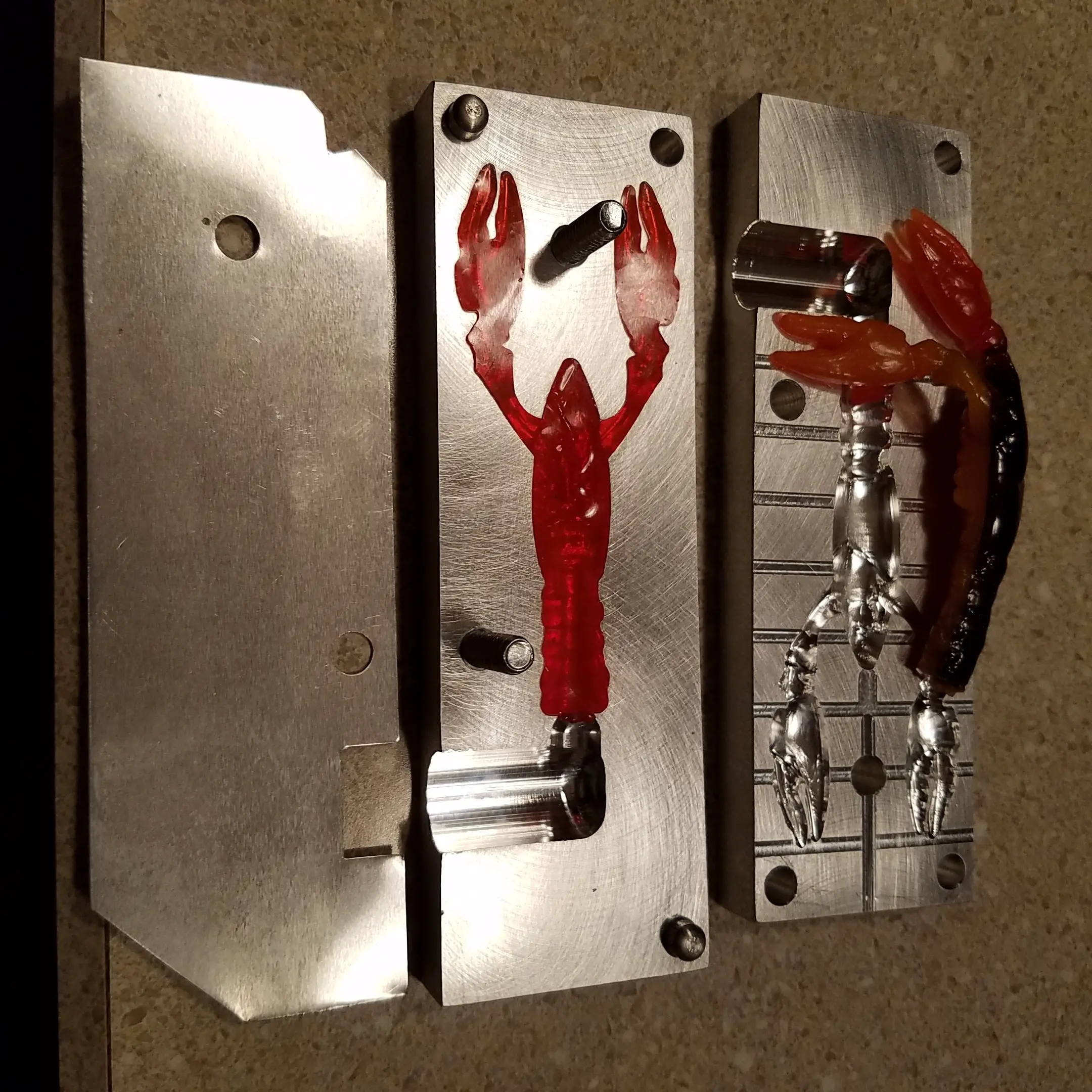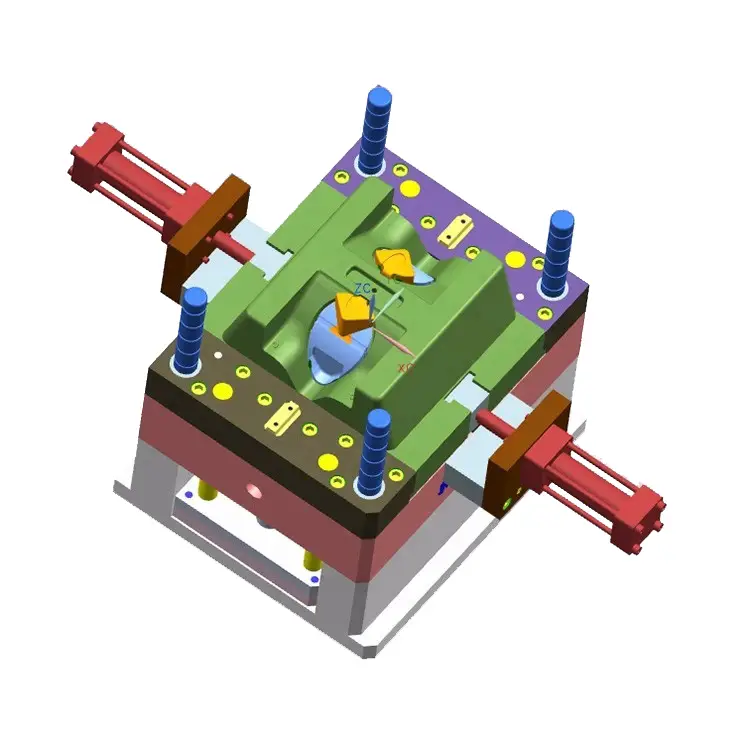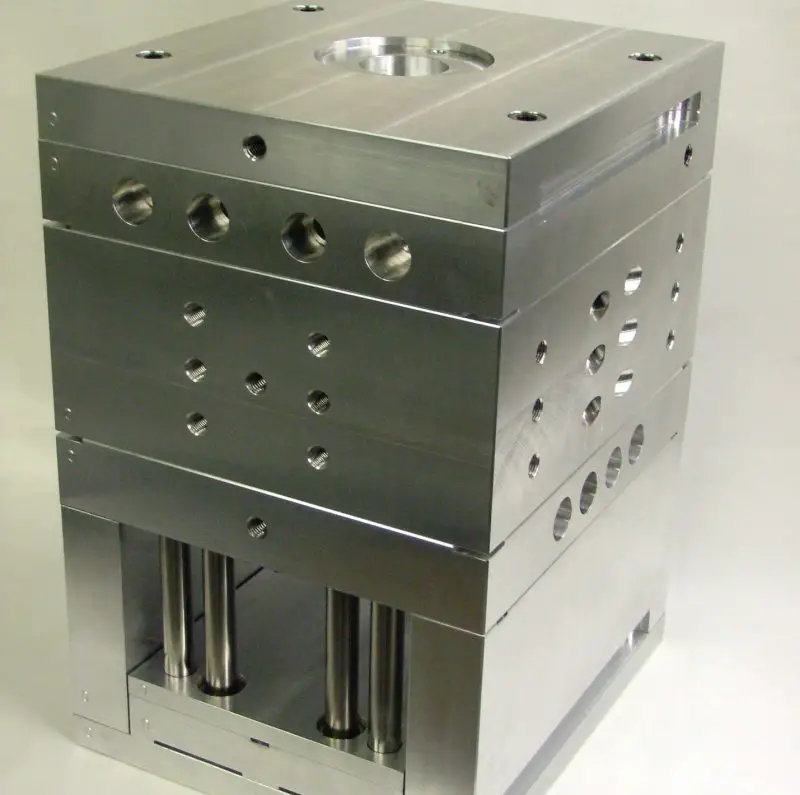Less Flash With Steel Molds
Flash is what happens when the plastic injection material seeps into the mold seams during the injection process. The excess material will need to be removed in post-processing. This post-processing can be expensive depending on the amount of flash and the work required to remove it. Aluminum molds for injection molding are prone to flash. Aluminum is a soft metal and is therefore easier to deform and allow the injected material to leak out of the machined cavity. Steel is a harder material, which reduces the chance for flash. Steel molds will not deform as easily as an aluminum mold.
Ease Of Design Modifications Steel Molds Vs Aluminum
Steel molds can be modified and repaired after initial tooling. Aluminum molds cannot be changed or repaired if there is a problem with the initial design. Steel molds can be modified with welding. If a part re-design requires less plastic in an area, and therefore, more steel in that area of the injection mold tooling, the steel mold can be modified. This is not the case with aluminum. Consider using a steel mold if there is any chance your part may undergo design revisions that will require modifications. Steel molds can also be repaired in some instances. This will save customers thousands of dollars by simply repairing the mold instead of machining a new mold. The ability to repair a mold will depend on the tooling. Not all steel molds will be able to be repaired.
When Should A Steel Injection Mold Be Selected
Given the advantages listed of aluminum, it is not always the best option for your new product. Steel has a storied history going back decades as has proven to last year after year producing millions of parts with tight tolerances. These are some of the reason steel may be a better choice for your new product:
- Amortization cost may be better over the lifetime of the part. Steel injection molds can produce millions of parts with the same quality, where aluminum typically will not keep the quality at high volumes.
- Steel injection molds can utilize designs with more than eight cavities.
- Part complexity can be increased with intricate designs and multiple inserts. Steel has the ability to hold tighter tolerances over a longer period of time or for a larger number of molding shots.
- Steel molds have more finishing options for surface texture than an aluminum mold. If you have a specific texture needed for customer marketing, or need a deeper texture for a specific function, steel may be the better choice.
Also Check: How To Get Tested For Mold Exposure
Contact Premier Engineered Products For All Of Your Aluminum Die Casting Needs
Once you have decided that aluminum die casting is the way to go for all your part manufacture needs, the next step is to contact Premier Engineered Products. We have been bringing great part designs to life for over 70 years with state-of-the-art equipment and highly trained engineers, making sure you get the best possible product manufactured in the most efficient way possible.
We are a family-owned, U.S.-based company that does all of our die casting in our cutting-edge die casting plant and have made high-quality parts for industries ranging from firearms to telecommunications to medical devices and more. Companies that know die casting call Premier Engineered Products.
At Premier Engineered Products, we are dedicated to helping you provide a better product to your customers by offering you great service and exemplary quality every time you place an order with us. Were sure we can help you with your metal part manufacturing needs regardless of your industry. To find out how we can put our high-tech metalworking machines and expertise to work for you now, just contact us online today.
Cost To Create Or Change Steel Molds Vs Aluminum Molds

The cost to create an aluminum mold is about ¼ to ½ the cost of creating a steel mold. In general, aluminum tooling will prove to be the most cost-effective option even when comparing a quote from a China-based vendor for steel tooling to a USA aluminum quote.
The type of mold you choose can also impact the cost of making changes. For example, aluminum tooling is roughly 1/10 the cost of changing a steel toolregardless of where it is manufactured. This is because it takes much longer and is harder to machine steel versus aluminum.
Recommended Reading: How To Stop Black Mold
Acrylonitrile Butadiene Styrene + Polycarbonate Blend:
- This injection molding thermoplastic is a combination of two different types of polymers.
- ABS has a high processing ability ratio and PC has a great array of mechanical properties along with impact and heat resistance.
- As these two polymers come together, the final product is a polymer that offers high resistance, excellent impact resistance, and has a good flow characteristic.
- PC+ABS offers combined properties of PC and ABS .
- The ratio of the two components affects the heat resistance of the final product.
- The blend exhibits excellent flow characteristics.
- It is mainly used in a wide variety of industries such as in computer and business machinery, electrical application, medical components, cellular phone, home products such as lawn equipment and automotive applications like interior trim, wheel covers and instrument panels and has a lot of finish options.
Read Also: How To Fight Mold In Basement
How Does Part Volumes Effect Tooling
Part volumes can effect tooling especially when the volumes reach a higher level. The standard is a single cavity tool for low volumes of a couple hundred or a couple thousand parts per year, but as the part volumes grow you can look to add multiple cavities on the tool to produce parts more economically. When quantities and life of project are unknown or there is no solid forecast, single cavity tools are a good place to start. You can always look at building multi-cavity tools later on. Multiple cavity tools come with a little more upfront cost on the tool but it can significantly lower the piece price on your part.
Does part material effect tooling?
Yes, it does. The part material has direct effect on tooling for a couple of reasons. Mild injection mold resins like a Polypropylene are a lot easier on a mold therefore contributing to a longer tool life. Harsher injection mold resins like a Glass Filled Nylon wear down a tool much easier. This can be a crucial deciding factor when your part has a life of 8,000-12,000 pieces and you are deciding between aluminum or steel tooling.
You May Like: How To Get Rid Of Mold In The Closet
Tip #: Fit Multiple Parts In One Mold
As we saw in a previous section, fitting multiple parts in the same mold is common practice. Usually, 6 to 8 small identical parts can fit in the same mold, essentially reducing the total production time by about 80%.
Parts with different geometries can also fit in the same mold . This is a great solution for reducing the overall cost of assembly.
Heres an advanced technique:
In some cases, the main body of 2 parts of an assembly is the same. With some creative design, you can create interlocks points or hinges at symmetrical locations, essentially mirroring the part. This way the same mold can be used to manufacture both halves, cutting the tooling costs in half.
Aluminum Injection Molding In Product Manufacturing
- Aluminum Injection Molding in Product Manufacturing
Injection molding is a manufacturing process used to produce prototypes and real products. It is reliable and efficient as it allows the production of complex product parts with better quality and yield. The injection molding process hugely depends on the design and materials used in better production. Therefore, manufacturers seeking simpler mold processes that allow for better products at a lower cost favor the use of aluminum injection molding.
Conventional injection molding process/steel injection molding process surely produces durable products. However, they leave a lot to be desired, as they do not guarantee quick production. In this article, we will discuss aluminum injection molds, their advantages, disadvantages, and features. Read on.
Also Check: What Happens If Your Exposed To Black Mold
Thermal Conductivity Of Aluminum Is 5 Times Greater Than Steel
Thermal conductivity is a materials intrinsic ability to transfer heat. The thermal conductivity of aluminum is about five times greater than steel. This is important because it directly impacts the fill, flow, and cycle time of aluminum molds.
Fill, flow, and cycle time: benefits of aluminum molds
- Material fills the mold faster and more evenly than steel molds
- Plastic can flow longer distances with less injection pressure in aluminum
- Cycle time is less due to quicker heating and cooling, meaning faster creation of your parts using aluminum molds
- Parts have minimal warp and much better dimensional stability giving a higher acceptance rate on parts
How To Build Aluminium Tooling Quick And Low Cost
Can you imagine making an aluminum mold and delivering hundreds of plastic parts in just three weeks? From mold design to mold built, our design team is devoted to developing a cost-effective and quick turn-around aluminum tooling approach:
Also Check: How To Remove Mold From Attic Rafters
Is Plastic Injection Molding Better Than 3d Printing
Plastic injection molding is better than 3D printing for larger production runs, stronger parts, faster production, and a larger variety of materials that can be used, including fillers. Because injection moldingâs manufacturing process simply involves the injection and cooling of plastic, a part can be formed within a few minutes at the most, as opposed to the layer-by-layer creation of a part via 3D printing. This makes it possible to make higher volumes of parts faster than a 3D printer, though building molds and other setup means that injection molding has a much longer original lead time. Parts are also stronger since theyâre not reliant on the bonds between each layer of plastic, which is important for products like car bumpers. At the same time, nearly all plastics can be injection molded, while 3D printing plastic materials do not yet have the same diversity.
The Disadvantages Of Steel Injection Molding

As with aluminum, there are some downsides to usingsteel tooling. Its crucial to include these factors in your considerationsduring the project planning stage.
- Difficult to Repair or Modify: If an incident occurs during production and a steel mold sustains damage, your only option may be to spend the money for a full replacement. Aluminum undergoes repair and reshaping more easily than steel, which is so strong that it often cant recover from deformation.
- More Defective & Rejected Parts: Aluminum molds cool rapidly compared to steel. That attribute allows for better heat dissipation, which reduces the risk of different areas of the part cooling at unequal rates. Steel molds have a higher rejection rate due to cracks and deformations caused by poor cooling.
Don’t Miss: How To Clean Mold Off Roof Shingles
Make Provision For Feasible Modifications
Throughout aluminum mold style, it is advantageous that your style consists of treatment for prospective modifications down the line. Although this may raise aluminum injection mold cost, it might confirm affordability later when improvement is required.
Making alterations without producing capabilities for such at the beginning start is possible. In most cases, it involves sacrificing the tool.
Steel Molds Can Handle Aggressive Materials
Injection molded material can impact the life expectancy of the tool. Aggressive materials like ASA/glass-filled Nylon and Ultem can reduce the lifespan of injection molds. Steel injection molds can be hardened through heat treatment to become extremely durable. The heat treatment will allow steel molds to handle the aggressive material without issue. Aluminum molds for injection molding cannot be hardened and will not be able to handle the high injection pressure and temperature required when injecting these aggressive materials.
Read Also: Does Black Mold Cause Breathing Problems
Choosing The Right Aluminum Alloy For Production Injection Molds
Aluminum may be a better solution than steel after a thorough review of part design, tool design, quantity and type of unfilled, aluminum-friendly resin.
This is a full production, aluminum mold that includes the AIM FRAME steel support pillars, steel DME U-Box and guided ejection. Also included are part line locks, a single drop hot tip and a mold cycle counter. This mold is constructed using 7050 alloy with high strength, heat-treated wrought aluminum alloy core/cavity inserts.
This is a picture of the industrial pump cover with molded in threads and brass inserts.
This is a production aluminum mold of an industrial pump cover constructed using 7050 aluminum alloy for Custom Molding Solutions, a Rochester, NY-based molder. Images courtesy of Aluminum Injection Mold Company.
With North American moldmakers and molders driving toward reducing costs, aluminum has made it to the forefront of tooling designers sketchpads and is really beginning to draw the question, What if we tooled this aluminum?.
More Surface Finish Options With Steel Injection Molds
Steel molds offer more options for surface finishes. The high-density nature of steel allows more texture selections. Custom, tall, or deep details in the tooling can be achieved by adding steel inserts. The number of surface finishes possible with an aluminum mold is limited and custom finishes are not available. The difference in available surface finishes is based on the mold material. This limitation affects all mold makers, not just ICOMold.
Also Check: What To Use To Kill Mold On Wood
The Benefits Of Aluminum Mold Tools For Injection Molding
Once we have designed your initial prototype you need to think about the next step in the production process: creating a pre-production prototype.
If youre unsure as to the difference between initial and pre-production prototypes, its relatively simple:
- Initial prototypes are typically created using CNC machines and/or 3D printers. They are simpler, cheaper, and faster to produce. The most difficult part of initial prototype production is getting the design correct. Generally speaking, initial prototypes are made from ABS plastic .
- Pre-production prototypes are typically created using injection mold machines. This requires the designer to use the CAD design to create an injection mold tool that will be used to generate roughly 300-1000 parts. Creating the mold tool is the primary expense in this process . Typically the pre-production prototypes are made from the same plastic as a final manufactured product so as to allow for realistic testing and/or research on the product as it will actually be when mass produced .
lack of strength, the truth is that a good aluminum tool is very robust. Typical pre-production prototype cycles only require several hundred to a thousand total replicas. An aluminum tool will last well beyond that requirement and in many cases could be used to produce several orders of magnitude more units in the event that even more in depth testing was required prior to mass manufacturing.
Thermal Expansion And Cooling Rate
Aluminum has a high coefficient of thermal expansion. Therefore, after heating to the right temperature, it can easily cool down which makes production fast.
This makes it an important material in the product manufacturing process that requires fast and effective production. It also makes it ideal for the injection molding process.
Also Check: How To Prevent Mold On Concrete Basement Walls
Aluminum Injection Molding Vs Steel Injection Molding
Conventional injection molding relies on steel injection molds to produce a large number of parts. However, steel molding possesses certain limitations. Therefore, there is a need for an alternative process like the aluminum molding process.
Based on different features, there are many differences between aluminum injection mold and steel plastic injection mold. This goes above the materials used in making them and is more based more on their features, designs, and applications.
Below are a few significant differences between aluminum mold and steel mold for plastic injection molding.
Things To Consider About Mold Making

Mold manufacturing entails accuracy and techniques and may involve block molds, glove molds, blanket molds, poured molds, and then some. The time may differ with various strategies regarding creating easy to complex geometry. The types of molds, like single or multiple cavities, can be picked as per requirements. Additionally, ensure access to adequate materials, provisions, and tools & equipment. Diverse material alternatives, such as aluminum and steel, are available, and each has specific features, capacities, and suitability. Nevertheless, the budget of the project is also one of the key things to consider, since mold making cost highly affects the final cost of injection molding.
Recommended Reading: Can Ptfe Be Injection Molded
Aluminum Molds Superior Thermal Control Can Reduce Cycle Time Up To 40%
In an article published in Moldmaking Technology1, Douglas Bryce provides details about an IBM tooling study of aluminum molds for high-volume production. The five-year study used identical steel and aluminum molds to produce identical plastic parts.
According to the study, the aluminum molds cost up to 50% less to build than steel molds and produced higher-quality parts. Further, the aluminum molds superior thermal control made it easier to manipulate areas of the tooling which resulted in cycle times up to 25-40% less than the steel molds.
